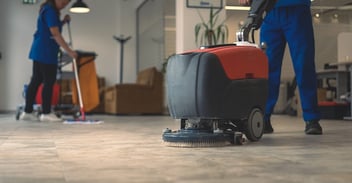

Introduction
Technology has transformed the way we live. While it is revolutionizing the way, we communicate and interact with one another, it's also affecting how businesses stay competitive in the 21st century.
In the modern world, companies need to stay on top of their game, which involves being technologically savvy. To help them do just that, facility managers are increasingly turning to new technologies- and there's no shortage of choices out there. They keep your facility running efficiently and effectively, subsequently shifting to integrated business management.
Why is the traditional way of facility management inefficient?
Typically, a facility management company works in isolation and plans individual projects based on clients' requirements. Using a traditional approach means that there is no effective way to measure the facilities' overall efficiency and thus improve upon them. It also lacks integration and standardization across facilities.
The traditional way of managing facilities is inefficient and time managing which requires accuracy in data collation for billing/Invoicing in varies stages of the operational process /approvals, that impacts both top and bottom line of revenue. Inefficient facility management, on one hand, causes in loss of revenue. On the other hand, it leads to rising input/operational costs which takes a toll on the Business P&L. Here are some challenges in the traditional way of managing facilities:
1. Loss of revenue due to revenue leakage:
Manual processes of capturing inputs of attendance and work completion leads to errors, and delay in approvals and invoicing. It causes incorrect billing and direct or indirect revenue leakage.
2. Increased cost due operational inefficiencies:
Sub-optimal utilization of resources causes inefficient allocation. Work orders can have a negative impact on the bottom-line and service deliverables.
3. Monitoring and tracking KPIs:
While managing large facilities it becomes cumbersome to aggregate data manually and create meaningful dashboards to track important KPIs through conventional methods
4. It is more time consuming:
The traditional method of facility management involves a lot of paperwork and manual work which consumes more time and effort than software-based paperless operations.
5. Lack of minute-to-minute coordination:
In a conventional working style, it becomes difficult to manage small but substantial activities, especially when you have a large staff.
6. Difficult for managing services at a ground level:
If you have multiple branches and service types, it is difficult to manually manage operations. It is inefficient and error prone.
7. Not suitable for all business types:
This working style is not suitable for all the corporate segments because most businesses require real-time data, which advanced software technology can achieve only in one click.
Possible solutions to revamp integrated facility management
The world has changed since 2020. Facility managers have had to adapt on the fly to accommodate a global pandemic that upended virtually every aspect of daily life. Now they are facing another challenge: the return of workers to office buildings following a prolonged period of remote work.
To meet these challenges and succeed in an ever-changing environment, facility managers need modern solutions that improve efficiency and support employees' safety and wellbeing.
Strategic execution through effective techniques
Strategic execution involves integrating business objectives with organization-wide data to improve efficiency and productivity. Strategic space planning tools allow for automated data collection, on-demand reporting, and continuous monitoring of office utilization. These tools provide a bird's eye view of how employees use facilities across multiple locations and help facility managers optimize the available space by considering changing needs over time.
Using Enterprise Asset Management software
This software helps facility managers manage equipment maintenance in real-time and automate asset tracking across departments or locations. It provides stakeholders with complete visibility into repair schedules, maintenance costs, downtime, and other metrics required to make informed decisions about facility investments. Hence, Enterprise Asset Management is a boon for the present management world.
Smart building technology
Smart building technology refers to employing solutions that use data to improve building performance and operations in a commercial or industrial setting. These kinds of smart building technologies are often used in facility management for their soft and technical services along with other allied services. Integrated facility management helps manage building operations. It includes everything from security to janitorial services, to their technical services, to foodservice and more.
Conclusion
For managing a facility, traditional decision-making methods are often time-consuming and inefficient. Facilities managers spend 95% of their time on administrative activities, such as budgeting, planning, and scheduling. That's why many businesses are trying to find ways to streamline their operations and increase productivity. Many have turned to technology to boost productivity among all levels in the organization.
Employing the latest technology in facility management can help you improve operations efficiency and smoother decision-making, reduce cost, increase profitability, critically analyze through articulate dashboards. It can also help enable quicker communication and workflow processes for effective running of operations and efficient services deliverables.
Frequently Asked Questions (FAQs)
Enterprise asset management (EAM) involves the management of mission critical assets of an organization throughout each asset's lifecycle. EAM is used to plan, optimize, execute, and track the needed maintenance activities with the associated priorities, skills, materials, tools, and information. The aim is to optimize the quality and utilization of assets throughout their lifecycle, increase productive uptime and reduce operational costs.
Enterprise asset management (EAM) involves the management of the maintenance of physical assets of an organization throughout each asset's lifecycle. EAM is used to plan, optimize, execute, and track the needed maintenance activities with the associated priorities, skills, materials, tools, and information.
The software helps in effective maintenance of assets through preventive, predictive, shutdown and breakdown maintenance strategies. The system also helps enterprises mitigate equipment risks by enhanced safety standards. The streamlined operations and improved asset performance helps organizations increase their investment effectiveness.
EAM is important because it helps organizations track, assess, manage and optimize asset quality and reliability. Asset intensive Organizations have hundreds, thousands, even millions of assets which needs to be maintained to maximize / optimize life of these assets to increase the return on investment.
The key features of effective EAM are:
- Work management.
- Maintenance Strategies (Preventive/ Predictive / Breakdown / Shutdown).
- Planning and scheduling.
- Supply chain management.
- Health and safety.
- Mobility.
- Analytics.
- Improved Asset Health at reduced cost through data driven maintenance Programs
- Complete visibilityon entire maintenance data across Equipment, across Models, across Branches to aid in analysis & decision making such as to Repair or Replace the Equipment
- Insightful analysis of Inspection Data to improve customer satisfaction
- Effective maintenance management enhanced by predictive maintenance and inbuilt analytics
- Increased reliability and safety, keeps complete track of all the inspections & calibration schedules
- Mobile Application enables users to execute work while “in the field” leading to minimized non-productive time and increased productivity and reduces duplication of work and human errors in recording information.
- Quick turnaround time through Actionable Notification & Alerts for every process in real time and accessible anytime and anywhere.
- Improved Regulatory Part of asset management involves the implementation of better O&M practices, which can significantly improve compliance.
Asset Intensive companies under the following Industries :
- Ports
- Cement and Mining
- Utilities
- Fleet Maintenance
- Equipment Rental
- Other Manufacturing
- Real Estate & Infrastructure
- Power Generation
Contact us for a meeting and schedule a demo
This differs on case to case basis, based on the type of installation and unique industry specific requirements. Contact us for a meeting and schedule a demo.
This differs on case to case basis, based on the type of installation and unique industry specific requirements. Contact us for a meeting and schedule a demo.
Stay Connected, follow us on LinkedIn / Twitter to know more about EAM Software latest trends.


